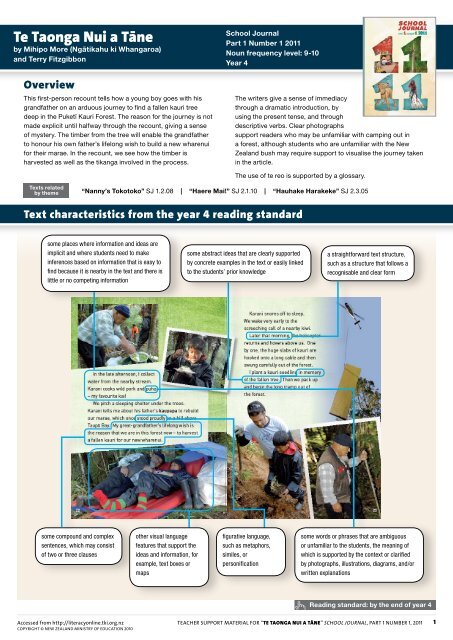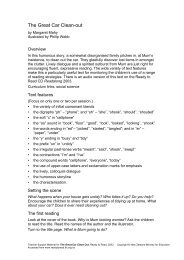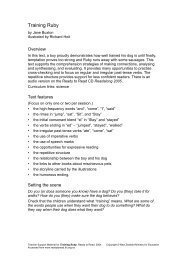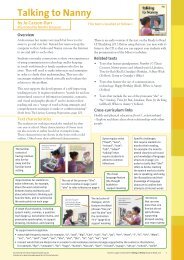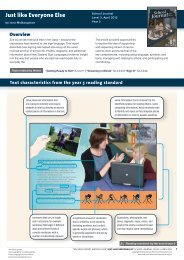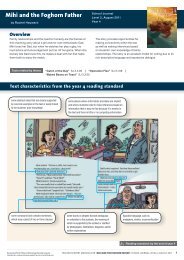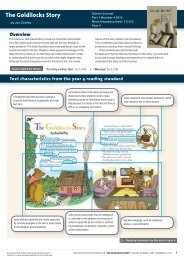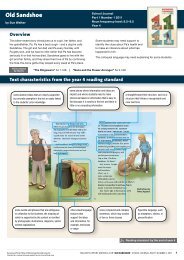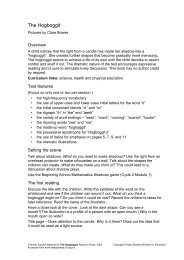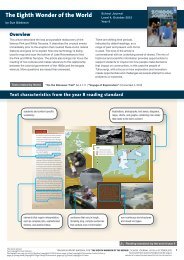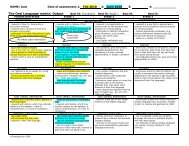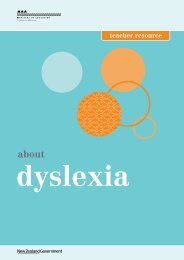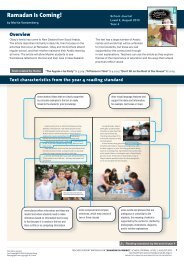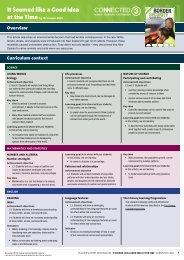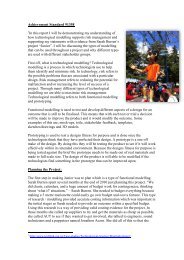Te Taonga Nui a Tane - Literacy Online
Te Taonga Nui a Tane - Literacy Online
Te Taonga Nui a Tane - Literacy Online
Create successful ePaper yourself
Turn your PDF publications into a flip-book with our unique Google optimized e-Paper software.
<strong>Te</strong> <strong>Taonga</strong> <strong>Nui</strong> a Tāne<br />
by Mihipo More (Ngātikahu ki Whangaroa)<br />
and <strong>Te</strong>rry Fitzgibbon<br />
Overview<br />
This first-person recount tells how a young boy goes with his<br />
grandfather on an arduous journey to find a fallen kauri tree<br />
deep in the Puketī Kauri Forest. The reason for the journey is not<br />
made explicit until halfway through the recount, giving a sense<br />
of mystery. The timber from the tree will enable the grandfather<br />
to honour his own father’s lifelong wish to build a new wharenui<br />
for their marae. In the recount, we see how the timber is<br />
harvested as well as the tikanga involved in the process.<br />
School Journal<br />
Part 1 Number 1 2011<br />
Noun frequency level: 9-10<br />
Year 4<br />
The writers give a sense of immediacy<br />
through a dramatic introduction, by<br />
using the present tense, and through<br />
descriptive verbs. Clear photographs<br />
support readers who may be unfamiliar with camping out in<br />
a forest, although students who are unfamiliar with the New<br />
Zealand bush may require support to visualise the journey taken<br />
in the article.<br />
The use of te reo is supported by a glossary.<br />
<strong>Te</strong>xts related<br />
by theme “Nanny’s Tokotoko” SJ 1.2.08 | “Haere Mai!” SJ 2.1.10 | “Hauhake Harakeke” SJ 2.3.05<br />
<strong>Te</strong>xt characteristics from the year 4 reading standard<br />
some places where information and ideas are<br />
implicit and where students need to make<br />
inferences based on information that is easy to<br />
find because it is nearby in the text and there is<br />
little or no competing information<br />
some abstract ideas that are clearly supported<br />
by concrete examples in the text or easily linked<br />
to the students’ prior knowledge<br />
a straightforward text structure,<br />
such as a structure that follows a<br />
recognisable and clear form<br />
some compound and complex<br />
sentences, which may consist<br />
of two or three clauses<br />
other visual language<br />
features that support the<br />
ideas and information, for<br />
example, text boxes or<br />
maps<br />
figurative language,<br />
such as metaphors,<br />
similes, or<br />
personification<br />
some words or phrases that are ambiguous<br />
or unfamiliar to the students, the meaning of<br />
which is supported by the context or clarified<br />
by photographs, illustrations, diagrams, and/or<br />
written explanations<br />
Reading standard: by the end of year 4<br />
Accessed from http://literacyonline.tki.org.nz<br />
Copyright © New Zealand Ministry of Education 2010<br />
<strong>Te</strong>acher support material for “TE TAONGA NUI A TĀNE” School Journal, Part 1 Number 1, 2011 1
Possible curriculum contexts<br />
SOCIAL SCIENCES<br />
Level 2 – Understand how cultural practices<br />
reflect and express people’s customs, traditions,<br />
and values.<br />
English (Reading)<br />
Level 2 – Purposes and audiences: Show some<br />
understanding of how texts are shaped for<br />
different purposes and audiences.<br />
English (Writing)<br />
Level 2 – Purposes and audiences: Show some<br />
understanding of how to shape texts for different<br />
purposes and audiences.<br />
Possible reading purposes<br />
• To find out about the harvesting of an old kauri tree for a<br />
special purpose<br />
• To identify the reasons for harvesting the tree and the<br />
customs that accompany the process<br />
• To compare customs associated with building in different<br />
cultures.<br />
Possible writing purposes<br />
• To describe a time when they participated in a special<br />
project<br />
• To describe customs or traditions they are familiar with<br />
• To research and explain some different ways of sourcing<br />
building materials.<br />
See Instructional focus –<br />
Reading for illustrations<br />
of some of these reading<br />
purposes.<br />
See Instructional focus –<br />
Writing for illustrations<br />
of some of these writing<br />
purposes.<br />
The New Zealand Curriculum<br />
<strong>Te</strong>xt and language challenges<br />
Vocabulary:<br />
• Use of onomatopoeia: “Thrump! Thrump! Thrump!”,<br />
“WHOOSH”<br />
• Possible unfamiliar words and concepts, including<br />
“duck down low”, “blast of wind”, “blades”,<br />
“scramble”, “cockpit”, “forest ranger”, “circles” used<br />
as a verb, “clearing”, “loggers”, “tramp”, “ancient”,<br />
“slabs”, “puha”, “pitch”, “sleeping shelter”, “rebuild”,<br />
“proudly”, “lifelong wish”, “harvest”, “screeching”,<br />
“hovers”, “seedling”, “in memory of”, “gobbled”,<br />
“boulder-hop”, “trudge”, “wearily”, “restoring the<br />
mana”<br />
• The use of figurative language: “the green korowai of<br />
the kauri” (metaphor), “stood proudly” (personification)<br />
Possible supporting strategies<br />
• Use strategies, including support from students familiar with te reo and tikanga, to<br />
familiarise students with words and customs they may not know.<br />
• Review the vocabulary used for the helicopter ride, the tramp, and the logging activity.<br />
• Some concepts may require explanation, for example, “peel back the green korowai of<br />
the kauri”; the generational links between the narrator, his grandfather, and his greatgrandfather;<br />
and the concept of “restoring the mana of our tūpuna”.<br />
• The English Language Learning Progressions: Introduction, pages 39–46, has some useful<br />
information about learning vocabulary.<br />
• ESOL <strong>Online</strong> has examples of strategies and approaches for focusing on vocabulary, at<br />
Pedagogy.<br />
• The use of te reo, supported by a glossary.<br />
Specific knowledge required:<br />
• Familiarity with tramping<br />
• Knowledge of tikanga Māori associated with nature,<br />
such as the use of karakia and the replacement of an<br />
old tree with a new one.<br />
<strong>Te</strong>xt features and structure:<br />
• Recount told in the first person<br />
• The use of sound (“Thrump! Thrump! Thrump!”) to<br />
start the article<br />
• The gradual revelation of the purpose of the journey<br />
• The use of the present tense for dramatic effect to<br />
narrate events from the past<br />
• The sequence of events with time markers (“Then”,<br />
“for two hours”, “At last”, “In the late afternoon”,<br />
“Later that morning”, “When we stop”, “is now”)<br />
• Clear photographs that show all stages of the journey<br />
• Long and complex sentences with several clauses and<br />
phrases, for example, “I feel the blast of wind … as I<br />
scramble into the cockpit with my karani and the forest<br />
ranger.”<br />
Possible supporting strategies<br />
• Discuss the sights, sounds, and actions the students would expect from being in a<br />
helicopter and in the bush or forest. Students with tramping experience can support others<br />
to understand the experience.<br />
• Remind students of school and community occasions when karakia have been used, for<br />
example, when gathering harakeke for weaving or before hui or meals.<br />
Possible supporting strategies<br />
• Review what students already know about the ways we can recount an experience orally<br />
and in writing. Support the students to identify the tenses we can use, particularly the<br />
use of the present tense to convey a sense of immediacy. Some students may need an<br />
explanation of how the present tense can be used to refer to the past.<br />
• Some students may require support to identify the sequence of events, especially if the<br />
context is very unfamiliar to them.<br />
• Supporting English Language Learners in Primary Schools: A Guide for <strong>Te</strong>achers of Years<br />
3 and 4 has a section on recounting. This offers guidance on language and activities that<br />
are suitable for learners at Foundation stage to Stage 3 of The English Language Learning<br />
Progressions.<br />
• Break long sentences up into phrases and clauses, identifying who, what, where, when,<br />
and the relationships between each phrase or clause.<br />
Sounds and Words<br />
Accessed from http://literacyonline.tki.org.nz<br />
Copyright © New Zealand Ministry of Education 2010<br />
<strong>Te</strong>acher support material for “TE TAONGA NUI A TĀNE” School Journal, Part 1 Number 1, 2011 2
Instructional focus – Reading<br />
Social Sciences (Level 2 – Structure: Understand how cultural practices reflect and express people’s customs, traditions, and values.)<br />
<strong>Te</strong>xt excerpts from<br />
“<strong>Te</strong> <strong>Taonga</strong> <strong>Nui</strong> a Tāne”<br />
Students<br />
(what they might do)<br />
<strong>Te</strong>acher<br />
(possible deliberate acts of teaching)<br />
The helicopter circles, and<br />
we land in a clearing deep in<br />
the bush. With two loggers<br />
who have also been flown<br />
in, we tramp for two hours<br />
down a rough track.<br />
The loggers peel back the<br />
green korowai of the kauri.<br />
Then they use special tools<br />
to saw the log into evensized<br />
slabs of timber.<br />
Students locate and evaluate<br />
information, and make connections<br />
with their own prior knowledge of<br />
going on an expedition, to make a<br />
hypothesis about the purpose of the<br />
journey.<br />
They use the title, the photographs,<br />
and the word “loggers” as clues.<br />
Students use what they know about<br />
figurative language and cross-check<br />
with the photographs to infer that<br />
the authors use the metaphor “the<br />
green korowai’” of the kauri to<br />
describe the cover of moss and ferns<br />
on the fallen tree.<br />
The students evaluate new<br />
information to make further<br />
hypotheses about the purpose of the<br />
journey.<br />
ASK QUESTIONS to support students to make connections with the<br />
text and to find clues that will help them form hypotheses about it.<br />
• What are some reasons why people might go into a forest?<br />
• Why might loggers go into a forest?<br />
• What clues from the title and the text so far help you to form a<br />
hypothesis about why the narrator and his grandfather are going<br />
into the forest with loggers?<br />
Be prepared to offer a lot of support for students who are not familiar<br />
with this context. Make links to your pre-reading discussions exploring<br />
the background and vocabulary.<br />
PROMPT students to notice the use of “the green korowai” of the<br />
kauri.<br />
• Why would the authors use this description? Who usually wears a<br />
korowai? Why is it green? What are the authors implying?<br />
• To help students make links to their prior knowledge, you could ask<br />
questions to prompt them to think about the notion of taonga. What<br />
kinds of things are treasured in your family and in other countries<br />
or cultures that you know about?<br />
ASK QUESTIONS to support students to clarify their understanding.<br />
• How had Karani prepared for the trip?<br />
We pitch a sleeping shelter<br />
under the trees. Karani<br />
tells me about his father’s<br />
kaupapa to rebuild our<br />
marae, which once stood<br />
proudly on a hill above<br />
Taupō Bay. My greatgrandfather’s<br />
lifelong wish<br />
is the reason that we are in<br />
this forest now – to harvest<br />
a fallen kauri for our new<br />
wharenui.<br />
My karani offers a karakia<br />
for the taonga given to us<br />
by Tāne Māhuta, as well as<br />
for the experience we’ve all<br />
shared.<br />
Students draw on their prior<br />
knowledge of camping or being<br />
in the bush to visualise the camp<br />
the narrator and his grandfather<br />
have made. They ask and answer<br />
questions to check that they<br />
understand the relationships.<br />
Students can now check their<br />
hypotheses against the actual<br />
purpose of the journey.<br />
Students make connections between<br />
the text and their own experiences<br />
of karakia to understand the<br />
importance of Karani’s actions.<br />
They draw on the knowledge they<br />
have of Tāne Māhuta and karakia<br />
to evaluate the concept of giving<br />
thanks for the fallen tree.<br />
Metacognition<br />
Ask questions to make the students’ strategies explicit for them.<br />
• What information helped you to form and check your hypotheses as you<br />
read the article?<br />
• What personal experiences and knowledge helped you to make<br />
connections with the article? How did they help you understand the<br />
text?<br />
• Find a place in the text where you made an inference. What clues helped<br />
you?<br />
• Some words in the article were used in ways that were new to you. How<br />
did you work these out?<br />
• What does “pitch” mean in this context? What would you usually<br />
associate with “pitch”? (a tent) You could ask students for other<br />
words that have more than one meaning. Emphasise that a reader<br />
looks at the whole context to understand a word. They need to<br />
recognise when a familiar meaning doesn’t make sense and find<br />
the correct meaning.<br />
• What do you think happened to the old wharenui?<br />
• What does “proudly” mean here? Is it an appropriate word to use<br />
for a wharenui?<br />
• Was the real purpose of the journey what you expected?<br />
If necessary, draw a simple family tree to show the generations<br />
(narrator, Karani, great-grandfather). Support students to clarify the<br />
relationships. Explain that the generation between the narrator and his<br />
karani would be the narrator’s mother or father.<br />
PROMPT students to make connections to their knowledge of<br />
Māori tikanga and of other customs they may have in their families or<br />
communities.<br />
• Why did Karani offer a karakia? What does it imply about his beliefs<br />
about nature and Tāne Māhuta’s guardianship of the forest?<br />
• Why do you think the karakia was for the shared experience, as<br />
well as for the kauri tree?<br />
• What special experiences of your own does this article remind you<br />
of?<br />
GIVE FEEDBACK<br />
• I noticed you changed your hypotheses as you read on. When you<br />
find new information, you often need to do this, especially when<br />
you’re not sure what will happen in a story.<br />
• You asked good questions about the roles of the people in this<br />
story. That’s a great way to get more out of your reading.<br />
Reading standard: by the end of year 4<br />
The <strong>Literacy</strong> Learning Progressions<br />
Assessment Resource Banks<br />
Accessed from http://literacyonline.tki.org.nz<br />
Copyright © New Zealand Ministry of Education 2010<br />
<strong>Te</strong>acher support material for “TE TAONGA NUI A TĀNE” School Journal, Part 1 Number 1, 2011 3
Instructional focus – Writing<br />
English (Level 2 – Purposes and audiences: Show some understanding of how to shape texts for different purposes and audiences.)<br />
<strong>Te</strong>xt excerpts from<br />
“<strong>Te</strong> <strong>Taonga</strong> <strong>Nui</strong> a Tāne”<br />
Examples of text<br />
characteristics<br />
<strong>Te</strong>acher<br />
(possible deliberate acts of teaching)<br />
Thrump! Thrump! Thrump!<br />
That’s the sound of the<br />
helicopter – and it’s coming<br />
closer. I can feel my heart<br />
beating fast.<br />
At last we arrive at the edge<br />
of a steep cliff. Lying on the<br />
forest floor is an ancient<br />
kauri tree, covered with<br />
thick moss and ferns.<br />
When we stop for a rest,<br />
Karani shows me a bunch<br />
of ripe miro berries. “These<br />
are good for sore throats<br />
and stomachs,” he says, “as<br />
long as the kākā and kererū<br />
haven’t gobbled them up<br />
first!”<br />
My karani is happy because<br />
we have taken another<br />
important step towards<br />
restoring the mana of our<br />
tūpuna.<br />
TEXT STRUCTURE<br />
Recounts usually have an orientation<br />
that lets the reader know what to<br />
expect. When an author departs<br />
from the usual orientation (for<br />
example, by using an exciting<br />
introduction) the reader wonders<br />
what will happen next.<br />
. Use of tense and time markers<br />
Use of the present tense lets the<br />
audience feel they are there with the<br />
narrator watching events as they<br />
happen. Time markers (“At last”)<br />
help the audience to understand the<br />
sequence of events.<br />
Use of dialogue<br />
Sometimes a small piece of dialogue<br />
can reveal a lot about a character. For<br />
example, dialogue can indicate the<br />
range of a person’s knowledge without<br />
the author needing to give extensive<br />
details.<br />
Implication<br />
Before a reader can infer meaning, the<br />
writer needs to imply ideas. Students<br />
need to learn how to imply ideas in<br />
their writing if this fits their purpose.<br />
Ask questions to help the students think about the effect the opening<br />
lines can have on the audience.<br />
• What kind of “first impression” do you want your writing to give?<br />
• How do your first sentences give your audience clues to the kind of story<br />
or article they’re about to read?<br />
Explain that recounts usually start with an orientation that gives the<br />
audience information such as when, where, what, and who.<br />
• What drawbacks might there be to using an unfamiliar or unexpected<br />
opening? Would this support or confuse your audience?<br />
• In your writing, try out some alternative opening lines and test their<br />
impact on a partner. Which opening lines work best for your purpose and<br />
audience?<br />
Explain the use of time markers to help us follow a sequence of events.<br />
Highlight examples of time markers in this text and discuss how they are<br />
used. Ask students to share examples from their own writing. Support<br />
students to use time markers appropriately in their writing, varying them<br />
when possible. Some students may need sentence starters to help them.<br />
Prompt students to focus on a small section of dialogue and how it is<br />
used to reveal more about a character.<br />
• What are the authors showing us by including this single sentence?<br />
• What does this sentence add to our overall picture of Karani as an older<br />
Māori man?<br />
• Look through your own writing. Are there places where a well-chosen<br />
sentence or two spoken by a character can show your audience<br />
something important about that character?<br />
Explain the difference between explicit and implicit.<br />
• The words say “we have taken another important step”. I infer that this is<br />
not the first step and it won’t be the last. I can see that Karani is getting<br />
old, so I infer that the task of building the new wharenui is one that the<br />
next generations will probably complete.<br />
• The fact that he took his grandson with him to get the kauri supports<br />
this inference. This fits with what I understand about the importance to<br />
Māori of passing down traditions through generations. The authors didn’t<br />
say this explicitly, but the words they used helped me to understand the<br />
implicit meaning.<br />
• Now look at your own writing and see if there are places where you can<br />
make changes to help your readers infer meaning and to make your<br />
writing more vibrant. Make them do some of the work too!<br />
Give feedback to affirm students’ writing decisions and guide their<br />
learning.<br />
• I see from your drafts that you tried some different openings, but you<br />
came back to the first one. As a reader, I now have a clear understanding<br />
of what the article will be about. It’s good to see how you’ve thought this<br />
through.<br />
Metacognition<br />
Ask questions to help the students think more deeply about purpose<br />
and audience when they write.<br />
• How often do you pause to check that your writing will meet the purpose<br />
you set yourself? What do you do if it seems to be going off course?<br />
• If you’re writing for an audience that doesn’t share your knowledge of<br />
…, how can you help them to understand the specialised information?<br />
• What do you want your readers to infer here? How did you imply that?<br />
• Your use of time markers is great – they helped me follow the adventure,<br />
which you’ve described well.<br />
• Thank you for adding the little piece of dialogue from your dad. It helped<br />
me to understand why camping was so important to him.<br />
• When you give each other feedback, I notice that you thank each other.<br />
That shows respect for the serious effort you’re putting into your writing.<br />
Well done!<br />
Writing standard: by the end of year 4<br />
The <strong>Literacy</strong> Learning Progressions<br />
Accessed from http://literacyonline.tki.org.nz<br />
Copyright © New Zealand Ministry of Education 2010<br />
<strong>Te</strong>acher support material for “TE TAONGA NUI A TĀNE” School Journal, Part 1 Number 1, 2011 4


